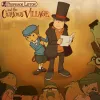Take a look inside 4 images
Professor Layton and the Curious Village
Pros: Fun, intriguing puzzles wrapped in a story and characters that will keep kids engaged to the end.
Cons: Heavily text-based, and costly/challenging for whole-class implementation.
Bottom Line: It's on Nintendo DS so it's not easy to weave into a classroom, but it's worth it, bridging ELA and math in complex puzzles guaranteed to absorb students.
Since it's a DS game, using Professor Layton in class can be challenging. However, many kids have a DS at home and can bring them in. Teachers then only need to get copies of the game and place students in groups of two or three to limit the number of systems and games needed. While it's a long experience, students will get exposed to a lot of math- and ELA-focused activities. The hint system and solid scaffolding means most students will be able to solve the math problems with minimal guidance from the teacher. Teachers may want to construct comprehension questions to accompany each game chapter to ensure that students are actually reading the text rather than racing through it to get to the next part of the game. Given its focus on story and the relatively large amount of text, Professor Layton can act as a game-based alternative to traditional novel reading with bonus coverage of math and critical thinking.
Players take on the role of the famous Professor Layton and his apprentice, Luke, who have been called to the mysterious village of St. Mystere to unravel the mystery of the Golden Apple, a puzzle left by the town’s baron to decide who will inherit his fortune. The town’s inhabitants are obsessed with puzzles and brainteasers, and often will not help the Professor on his quest until he solves puzzles for them.
Players use the Nintendo DS touch screen to interact with objects in and around St. Mystere. Tapping random objects –- anything from a curious painting to a random lightpost -- will elicit an observation from Luke or the Professor, or reveal hidden puzzles or hint coins, which can be used to purchase hints on particularly difficult puzzles. There are also several mini-games –- finding objects to furnish the hotel room, assembling “strange gizmos” to create a robotic dog that will sniff out hint coins, and the like –- that encourage players to keep looking for more puzzles. As the game progresses, players keep track of the mysteries and story line in a journal. Each mystery is closed as the plot resolves.
The puzzles are interesting, intricate, and varied, and require higher-order thinking skills. Although some of the puzzles can be difficult, the game rarely forces players to solve them in order to progress. All puzzles can be stored and accessed at a later time, allowing players to avoid frustration and return later. And if things get too frustrating, players can bail themselves out with hint coins. Although Professor Layton is a single-player game, it lends itself well to partnerships and collaborations. Students enjoy working in pairs and solving the problems together.











